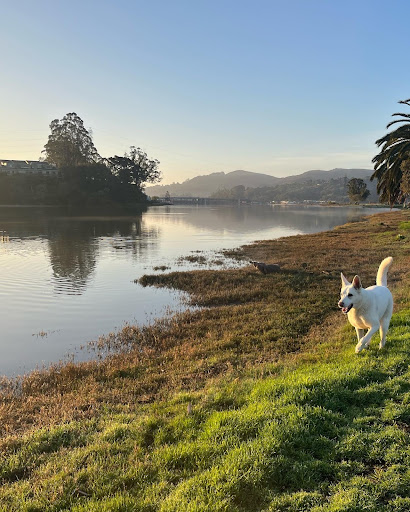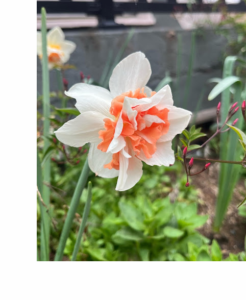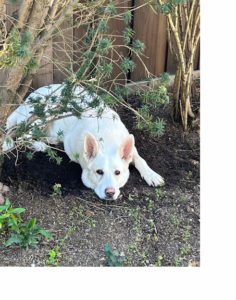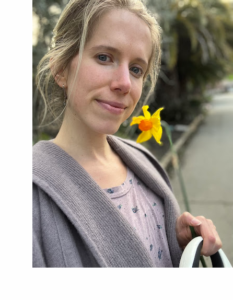Mud & Magnolia: Declaring Your Authentic Beauty This Spring
posted by Martha Krausz / April 10, 2023

On the night of the vernal equinox (here in the northern hemisphere), I participated in a meditation with spiritual guide and yoga teacher, Clara Roberts Oss. Some of our Zoom rooms showed dimly lit squares, bedrooms flickering with easy flames; others burned a bright blue-white of an overhead kitchen light. Some boxes were motionless with only the silhouette of a cross legged form, others a flash of a body still fixing, situating, arriving. Together we were a quilt of dark and light, of movement and stillness–a whole.
With closed eyes, Clara described Lakshmi, the Hindu goddess of beauty and power. She painted for us a woman resplendent in gold bangles, colorful textiles and jewels—a woman adorned and decorated with vibrant external beauty. This image gave way to the image of the garden in which she sat, and inspired our own visualizations: what new beauty (in the most expanded sense of the word, and in all aspects of our lives) do we want to cultivate this season? What new seeds do we want to plant? What does our garden look like? What needs nourishment? What’s growing now but might need to be attended to?
 In spring, especially, a Lakshmi-like blooming and visible abundance surrounds. It is the sort of beauty we have all been conditioned to see and celebrate. The trees, bejeweled in pink and white; the robins’ copper breast kissing the morning grass. Where I live, wildflowers are beginning to spill over hillsides like fallen beads. Crickets click and pop, the air against their wings like an atmospheric bubble wrap cracking open the gift of spring. Just yesterday, a daffodil’s peach-coral-pink ruffle made me say if I were a flower I’d want to be that. A befuddling and beguiling beauty, spring wears. She can leave us feeling awestruck and deferent, as if kneeling at her goddess feet.
In spring, especially, a Lakshmi-like blooming and visible abundance surrounds. It is the sort of beauty we have all been conditioned to see and celebrate. The trees, bejeweled in pink and white; the robins’ copper breast kissing the morning grass. Where I live, wildflowers are beginning to spill over hillsides like fallen beads. Crickets click and pop, the air against their wings like an atmospheric bubble wrap cracking open the gift of spring. Just yesterday, a daffodil’s peach-coral-pink ruffle made me say if I were a flower I’d want to be that. A befuddling and beguiling beauty, spring wears. She can leave us feeling awestruck and deferent, as if kneeling at her goddess feet.
Like the magnolia showing its pink and white, spring can be a time for us to bloom too; a time when we let our bodies and bodies of work unfurl, and step into the light. During a lunch break, I unpeel the long sleeve and expose my beauty-marked shoulders; I unroll my yoga mat onto the patio and let the abalone luster of lines stretching across my hips and thighs shine. In spring, we are sometimes tempted to reveal what was clothed or concealed; we might hold out the bouquet of our visible, physical beauty in the spring’s new light.
It’s also a period when our bodies of work—the limbs of new ideas, projects, stories, and dreams start to bud and break through the soil, untangle from the roots of our fear and reach towards the sunlight of being witnessed in community. Students present final projects. Lovers confess their love and hold hands. Writers ready the first chapters of their novel, or submit an essay to a contest. Whether you are an artist, entrepreneur, at-home parent, carpenter, leader, student (insert your craft/ profession here), I wonder if now is also when your nonphysical beauty begins to wave its hands, daring to join a larger garden.
But spring’s beauty—and the beauty of our beings—is not all daffodils and daisies. Authentic, whole-person beauty is not just full of our flowery presentations and final drafts. If you haven’t noticed, spring is also damn messy. Damn muddy, to be specific.
The Body Positive continually helps remind me that, to witness the whole beauty of ourselves and our worlds, we must also include its muddier side. E. E. Cummings begins his springtime poem, “[In-Just-],” “In Just-/ Spring when the world is mud-luscious . . . . / when the world is puddle-wonderful.”
Spring is a season of slime, slip, and smear; of making a mess in mud, playing in puddles, leaving tracks and dirtying up the place. In my yard the hair-whipping, blossom-twirling winds blow solid pink through my yard; by the time they pass, across the slate a carpet of slick magnolia petals lies, a wobbly welcome mat on which a morning heel slips, then catches itself—thank goodness—on its way out the door. And there’s my dog, the shortbread of his body dipped chocolate dark in the pudding of a cold morning mud where we walk. After our walk, I wrangle each of Alfredo’s paws only halfway into a scented wet-wipe; inside, our muddy footprints track across old towels that barely cover the carpets.
Some of the spring mud I cannot, and do not wish to, wipe away. There is still the mud of my mind, my creative life, the spring of my being: a fertile, nutrient-rich sediment and space of play, ideation, experimentation, creation. All seasons signal a shift, but perhaps spring is thickest with the wonderful mess and primordial goo of new intentions, the seeds of new projects, new movement of making new things. This mud is dark. It can be scary. It can feel dangerous. My mud is made of the many essay drafts sitting in open tabs on my laptop like standing puddles ( a thin algae has begun to grow over some) and the ones that rush towards the ocean of publication like rivers, wild and wanting; it contains the seeds of the writing workshops that I’m not ready to pitch to my community; my mud is the flesh of my thighs where hamstring meets butt, always changing in shape and size, in strength and softness, as I live the life of both writer and mover (body, and body of words).
Mud, metaphorically speaking, is the space of mystery. Of the unknown and often uncontrollable. It is the space of being, of daring to create a life and shape guided by your own felt sense, rather than by the societal trellises and espaliers that direct us.
This dynamic mud of our lives and our bodies can overwhelm the critic or controller in us: awaken in her the terror of swimming inside the still inchoate, the I-don’t-quite-know-yet-what-I’m-doing waters of being, becoming, wondering. But it’s also the source of what roots us to ourselves, connects us to each other, and welcomes us to stand in our full, authentic beauty.
In his lecture “The Coincidence of Opposites,”Alan Watts reminds us of the inextricability of opposites; how the binaries that organize concepts (flower and mud, pretty and ugly, clean and dirty, light and dark, sound and silence, good and bad, life and death, being and non-being, front and back) collapse under honest examination. He notes that each side of an opposite is certainly different, but insists that these diverse sides of our reality are at the same time one. He reflects, “One has to fundamentally get used to the notion that different things can be inseparable; that what is explicitly two can at the same time be implicitly one.” There is no front without back, light without dark, sound without silence. The mud and flowers of our lives are different, but they are also interdependent; they cannot exist without the other.
Take the lotus flower. In the wild, the lotus pushes its way through the darkness of heavy mud, rising toward the sun’s light. When the lotus emerges, its first petals open. The lotus has been metaphorically crowned as the beautiful survivor. The mud through which it rises has come to represent obstacle, hardship, and suffering. But why is it that mud is saturated with only negative narratives? Yes, mud can overwhelm and bury. But isn’t mud also the stuff of play? Of face paint, and slipping and sliding, of castles and mud cakes; the place of birth, regeneration and growth? The other night, my partner said, “Name one thing that doesn’t come from dirt . . .you can’t!” True, the lotus pushes through and against mud, despite mud. But the simultaneous truth is, it also came from mud. Mud is the medium and foundation of everything. Flaura, fauna, and landscapes everywhere depend on mud, rich with nutrients, minerals, and microorganisms, to survive.
 The lotus blooms not despite the mud but because of mud. The mud and the lotus are different, yes. But they are not separate; and one is neither more important nor more beautiful than the other.
The lotus blooms not despite the mud but because of mud. The mud and the lotus are different, yes. But they are not separate; and one is neither more important nor more beautiful than the other.
I wish we could look at the lotus and, just as peacefully, remember the mud. That we could take in the whole landscape of our beauty, not ignoring or prioritizing any single piece of the portrait.
When the lotus blooms, must we discard or compartmentalize all thoughts of the mud in which it was birthed? Authentic beauty has no chronology, no hierarchy, no end goal. It is all a blossoming.
Why am I making such a fervent case for mud? Our capacity to embrace and see the beauty and necessity of mud, I think, circumscribes our capacity to celebrate and appreciate our whole authentic beauty. We too run the risk of interpreting beauty like many interpret the lotus flower: of ignoring and undervaluing the mud in us and around us; of idolizing only the flowery parts, staying fenced inside narrow and stifling beauty standards. When we operate inside these narrow beauty ideals, so much of the soil of us is systemically, poetically, and politically shoveled away, wiped “clean”; ignored, denied.
The stakes of forgetting our mud are high. To bifurcate the flowery parts of us from the mud of our being is to fall into the game of fear, control, and division. In Watts’ words, “If we forget that black and white are inseparable, and that existence is constituted by both being and nonbeing, we get scared.” When we get scared of differences/opposites, we pit one side against the other. When we find ourselves in fear, in need of protecting against what and who we think is separate from us, we take up arms against the parts of our world that we need most to embrace. Mud, in our minds, is suddenly the enemy of flowers, fat the enemy of skinny. In other words, when we make an enemy of one side, we cling desperately to the other. Suddenly skinny must win against fat. Curated and controlled bodies must war against the larger, softer bodies. This can lead to small and large crimes: we glare at the girl in the bakery who has a more “put together” outfit than us; entire populations oppress and enact violence against other people, genders, body types.
To think in flower or mud is to live in fear and in denial of our wholeness. To think in flower and mud is to connect, to love, to surrender to the sweet mess of being human among humans, as one.
 I am living an extended mud season. My thirtieth year of writing, leading, creating, is fecund but largely formless, magical but messy, unstoppable yet uncharted. Life right now is as muddy as some sections of the Bay Area trails. The morning after Clara’s meditation, I went on a walk in Kentfield with my dog and his bff. Around the camber of a curve, a small puddle became a lagoon. There was no highland onto which I could edge my boot, no sandbar to separate me from the mire of mud. I stopped my walking and watched Alfredo & his best buddy, Teddy, prance across the murky waters painting their sides an appaloosa splatter. How do they not care? I first thought. Then I remembered how, as a child, I did not care either, that I only learned to care at some point, and had been pretending to care. For whom? I am still not entirely sure. A relief set me back into motion and I walked through, imagining myself part of the herd—a horse, carrying something precious through the mud to the other side. I feel an unburdening as I cease to look for a way out; as I release the work of scanning for a way to stay dry, clean, muddless.
I am living an extended mud season. My thirtieth year of writing, leading, creating, is fecund but largely formless, magical but messy, unstoppable yet uncharted. Life right now is as muddy as some sections of the Bay Area trails. The morning after Clara’s meditation, I went on a walk in Kentfield with my dog and his bff. Around the camber of a curve, a small puddle became a lagoon. There was no highland onto which I could edge my boot, no sandbar to separate me from the mire of mud. I stopped my walking and watched Alfredo & his best buddy, Teddy, prance across the murky waters painting their sides an appaloosa splatter. How do they not care? I first thought. Then I remembered how, as a child, I did not care either, that I only learned to care at some point, and had been pretending to care. For whom? I am still not entirely sure. A relief set me back into motion and I walked through, imagining myself part of the herd—a horse, carrying something precious through the mud to the other side. I feel an unburdening as I cease to look for a way out; as I release the work of scanning for a way to stay dry, clean, muddless.
I smiled at the hiker facing me, coming in my direction. I saw her also pause, and consider what I had. The joy of knowing that mess, that mud, was the only way.
RESOURCES
Prompts (to write or reflect on):
- What is your spring mud? What does your spring mud consist of? What is still inchoate, messy, and in-process—perhaps dark, mysterious, and a little risky? In your creative life? In your work and social life? In your body? In the body of work you are creating? How might this be a fertile ground this year, full of nutrients?
- What are the flowers in your life? What is already blooming or beginning to bud in your community, in your space, in your body? What in your life is the magnolia you snap a photo of and send to a family member/friend? The daffodil you pick and hand someone, the bouquet you’ve brought to the table of your work life, social life, etc.?
- Make the connection. How are these two parts of your life, perhaps opposites in some way, connected to each other, inextricable from the other?
Listen, Move, Learn
- E.e. Cummings’ poem, “[In-Just-]
- “To Be Made Whole”—A conversation brought to you by the On Being Project with poet Ada Limón & host, Krista Tippett.
- “Magic, Everyday Mystery, And Getting Creative”—Another On Being conversation with guest Rick Rubin & host, Krista Tippett.
- Practice With Clara—“Clara Roberts-Oss Yoga believes that much of the spiritual practice is about ‘lila,’ cosmic play. When we play, we open ourselves to the unfolding while in the process. Her yoga is “ less about the goal and more about the evolution.” PWC offers a space to advance your yoga practice with a wide range of class styles to accommodate yogis of all levels.
- Alan Watts Lecture “The Coincidence of Opposites”
